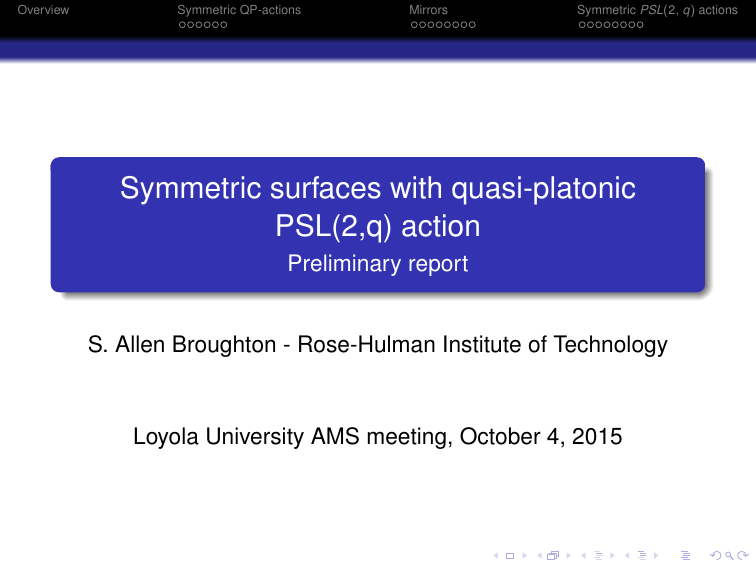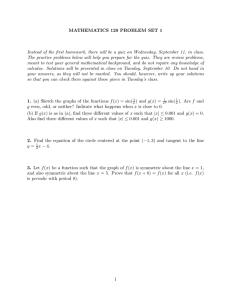Symmetric surfaces with quasi-platonic PSL(2,q) action
advertisement

Overview
Symmetric QP-actions
Mirrors
Symmetric PSL(2, q) actions
Symmetric surfaces with quasi-platonic
PSL(2,q) action
Preliminary report
S. Allen Broughton - Rose-Hulman Institute of Technology
Loyola University AMS meeting, October 4, 2015
Overview
Symmetric QP-actions
Mirrors
Symmetric PSL(2, q) actions
Overview
Overview of sections
Symmetric Quasi-Platonic (QP) Actions.
Mirrors of Symmetries.
Symmetric QP PSL2 (q) actions - prior and new results
(Macbeath, Singerman, Broughton et. al, Tyszkowska).
Motivations
Why symmetries? Symmetries are complex conjugations
of a surface defined over R. The mirrors are real curves.
Why PSL2 (q)?
simple group, many low genus actions, numerous
symmetries, nice group structure, easy calculations.
Overview
Symmetric QP-actions
Mirrors
Symmetric PSL(2, q) actions
QP actions and symmetric QP actions
QP actions - definition
Definition
The finite group G acts conformally on the closed,
orientable Riemann surface S if there is a monomorphism:
: G → Aut(S),
where Aut(S) is the conformal automorphism group of S.
An action is quasi-platonic if:
The quotient surface has genus zero: S/G w P 1 (C).
The quotient map: πG : S → S/G = P 1 (C) is ramified over
three points.
Overview
Symmetric QP-actions
Mirrors
QP actions and symmetric QP actions
Symmetric QP actions - example
Discuss: QP-action in this picture.
Explain the term quasi-platonic.
Show symmetries, mirrors, and separation.
Symmetric PSL(2, q) actions
Overview
Symmetric QP-actions
Mirrors
Symmetric PSL(2, q) actions
QP actions and symmetric QP actions
Construction of actions - summary
Let p, q, r be the reflections in the sides of a (hyperbolic)
2π 2π
triangle on the surface with angles 2π
l , m, n .
Let a = pq, b = qr ,c = rp be the rotations at the corners of
the triangle. Define an action by identifying a triple
(a, b, c) ∈ G3 with the rotations of the same name.
We call (a, b, c) a generating (l, m, n)-triple of G. The
assignment defines an action as long as the following hold.
G = ha, b, ci
(1)
o(a) = l, o(b) = m, o(c) = n
(2)
abc = 1
(3)
The genus σ of S satisfies
1
1
1
2σ − 2 = |G| 1 − −
−
l
m n
Overview
Symmetric QP-actions
Mirrors
Symmetric PSL(2, q) actions
QP actions and symmetric QP actions
Symmetries and QP actions
Definition
A symmetry or reflection on a surface S is an anti-conformal
involution ϕ of S. A QP action : G → Aut(S) is symmetric if
there is a symmetry ϕ normalizing the action of G, namely
ϕ(G)ϕ = (G).
For a symmetric QP action:
Denote by θ the induced involutary automorphism of G
θ(g) = −1 (ϕ(g)ϕ).
Define G∗ = hθi n G, and extend the action
: G∗ → Aut∗ (S) = hAut(S), ϕi by θ → ϕ.
Overview
Symmetric QP-actions
Mirrors
Symmetric PSL(2, q) actions
QP actions and symmetric QP actions
Macbeath-Singerman symmetries
If ϕ = q is a symmetry then automorphism θ satisfies
θ(a) = a−1 , θ(b) = b−1 .
with similar formulas for p and q.
The reflections p, q, r are sometimes called Macbeath Singerman symmetries.
The local reflection q extends to symmetry of the entire
surface if and only if an automorphism θ, satisfying the
above equation, exists.
Overview
Symmetric QP-actions
Mirrors
Symmetric PSL(2, q) actions
QP actions and symmetric QP actions
Types of symmetries
Symmetries come in two types, depending on whether θ is an
inner or outer automorphism.
If θ is inner, then G∗ ' G × Z2 assuming G is centerless. In
this case S has fixed point free symmetries.
If θ is outer then S has no fixed point free symmetries. If
G = PSL2 (q) then G∗ = PGL2 (q)
Overview
Symmetric QP-actions
Mirrors
Symmetric PSL(2, q) actions
Mirrors
Mirrors - definitions
Definition
Let ϕ be a symmetry or reflection on a surface S.
The fixed point set Mϕ of ϕ is called the mirror of the
symmetry.
The mirror Mϕ is a disjoint union of circles called ovals.
The symmetry ϕ is called separating if S − Mϕ consists of
two disjoint mirror image pieces, otherwise it is called
non-separating.
Overview
Symmetric QP-actions
Mirrors
Symmetric PSL(2, q) actions
Mirrors - ovals
Number of ovals
The centralizer
CentG (q) = {g ∈ G : θ(g) = g}
acts transitively on the ovals of the mirror of q.
The stabilizer of an oval is dihedral or cyclic (next slide).
The subgroup of rotations of the stabilizer of an oval can
be computed from the edge pattern of the oval (next slide).
Similar results hold for p and r .
The number of ovals can be computed using the
orbit-stabilizer theorem.
Overview
Symmetric QP-actions
Mirrors
Mirrors - ovals
Edge patterns and oval rotations
Discuss: Show PQR patterns of ovals.
Describe oval rotation.
Symmetric PSL(2, q) actions
Overview
Symmetric QP-actions
Mirrors
Symmetric PSL(2, q) actions
Mirrors - ovals
Partial edge pattern table
Four of eight patterns shown.
l = 2λ + 1 or l = 2λ
m = 2µ + 1 or m = 2µ
n = 2ν + 1 or n = 2ν
even
exponents
l
l, m
l, m, n
odd
exponents
l, m, n
m, n
n
basic PQR pattern
oval rotation
P +Q+R+
Q+R+P +P −R−Q−
Q+Q−
R+P +P −R−
P +P −
Q+Q−
R+R−
a−λ b−µ c −ν
b−µ c −ν a−λ c ν bµ aλ
b µ aλ
c −ν aλ c ν bµ
aλ c ν
b µ aλ
c ν bµ
Overview
Symmetric QP-actions
Mirrors
Symmetric PSL(2, q) actions
Mirrors - separability
Fixed point formula
We have two ways of determining separability of mirrors. One
way uses fixed point formulas. We first note a fixed point
formula for g ∈ G.
Proposition
Fixed point formula for g ∈ G
|S g | = |NG (hgi)|(δl (g)/l + δm (g)/m + δn (g)/n)
where δl (g) = 1 if g is conjugate to a power of a, and 0
otherwise. Similar definitions for δm (g), δn (g).
(4)
Overview
Symmetric QP-actions
Mirrors
Symmetric PSL(2, q) actions
Mirrors - separability
Mirrors - separability - 1
For each pattern Bi let M(ϕ, Bi ) be the union of all the ovals in
Mϕ with edge pattern Bi .
Theorem
Suppose a has even order and let h be the involution aλ . Then
if q is separating we have the fixed point inequality:
h
S ≤ 2 |M(q, B1 )| + · · · + 2 |M(q, Bs )| .
Theorem
Suppose a has odd order. Then if q is separating we have the
fixed point equality:
|NG (a)|
= |NG (a) ∩ CentG (q)|
l
Overview
Symmetric QP-actions
Mirrors
Symmetric PSL(2, q) actions
Mirrors - separability
Mirrors - separability - 2
Notes:
If q is separating then all the fixed points of a or h must lie
on the mirror Mq . The right hand side of the equations
count or estimate the number of these fixed points.
Typically one proves that symmetries are non-separating
by showing that the left hand sides are much larger than
the right hand sides.
The fixed point formulas don’t always work.
Overview
Symmetric QP-actions
Mirrors
Symmetric PSL(2, q) actions
Mirrors - separability
Mirrors - separability - 3
The second method involves counting triangles.
Theorem
There is an easily implemented computer algorithm that counts
all the elements of G∗ corresponding to triangles lying on one
side of the mirror Mq . The mirror Mq is separating if and only
if the count terminates with |G| = |G∗ |/2 elements.
Overview
Symmetric QP-actions
Mirrors
Symmetric PSL(2, q) actions
Some results and conjectures
Prior results
Theorem
(Macbeath) Every quasi-platonic action of PSL2 (q) has
Macbeath-Singerman symmetries.
(Broughton et al.) The symmetries of Hurwitz actions have
been completely characterized. All symmetries with
non-empty mirrors symmetries are non-separating. Trace
arguments in SL(2, q) are used.
(Tyszkowska)There is a Harnack like theorem describing
the maximum number of ovals of a Macbeath-Singerman
symmetry of a PSL(2, q) action. The oval rotations and
trace arguments are used.
Overview
Symmetric QP-actions
Mirrors
Symmetric PSL(2, q) actions
Some results and conjectures
Easy results
(originally proven in Broughton et al. for Hurwitz actions)
The Macbeath Singerman symmetries are all conjugate.
Therefore every mirror has ovals of each pattern type.
If q is not divisible 3 and q > 7 then all of the
Macbeath-Singerman symmetries for hyperbolic (2, 3, n)
and (3, 3, n) actions are non-separating.
Overview
Symmetric QP-actions
Mirrors
Symmetric PSL(2, q) actions
Some results and conjectures
Conjectures
Conjecture
All Macbeath-Singerman symmetries of PSL2 (q) are
non-separating.
See next slide.
Overview
Symmetric QP-actions
Mirrors
results
Sample results
Show tables of Symmetric QP-actions
Symmetric PSL(2, q) actions
Overview
Symmetric QP-actions
Mirrors
Symmetric PSL(2, q) actions
results
Computational Tools
We used Magma to compute all the results shown. For faster
computation and for general results we can try traces in SL2 (q)
as follows (see Broughton et al, Glover-Sjerve and
Tyszkowska).
For each possible order n of an element in u ∈ PSL2 (q)
there is a universal polynomial fn (τ ) ∈ Z[τ ] such that
ord(u) = n if and only if fn (Tr (U) = 0 for any covering
element of u.
The trace of any word in A, B, C can be easily computed as
a polynomial in {α, β, γ}. In particular this can be done for
oval rotations.
Overview
Symmetric QP-actions
Mirrors
done
Any Questions?
Symmetric PSL(2, q) actions
Overview
Symmetric QP-actions
Mirrors
Symmetric PSL(2, q) actions
done
References
S.A Broughton, E. Bujalance, A.F. Costa, J.M. Gamboa, G,
Gromadzki, Symmetries of Riemann Surfaces on which
PSL(2, p) acts as a Hurwitz automorphism group, J. Pure
Applied Algebra 1996) pp. 113-126
H. Glover & D. Sjerve, Representing PSL2 (p) on a Surface
of Least Genus, L’Enseignement Mathématique, Vol. 31
(1985), pp. 305–325.
H. Glover & D. Sjerve, The Genus of PSL2 (q), J.reine
angew. Math, Vol. 380 (1987), pp. 59–86.
Overview
Symmetric QP-actions
Mirrors
Symmetric PSL(2, q) actions
done
References - continued
A.M. Macbeath, Generators of the Linear Fractional
Groups, Proc. Symp. Pure Math. Vol. XII, Amer. Math.
Soc. (1969), pp. 14–32.
D. Singerman, Symmetries of Riemann surfaces with large
automorphism group, Math. Ann. 210, (1974) 17-32.
E. Tyszkowska, On Macbeath-Singerman Symmetries Of
Belyi Surfaces with PSL(2, p) as Group of Automorphisms,
Central European J. of Math. (2003) pp.208-220



